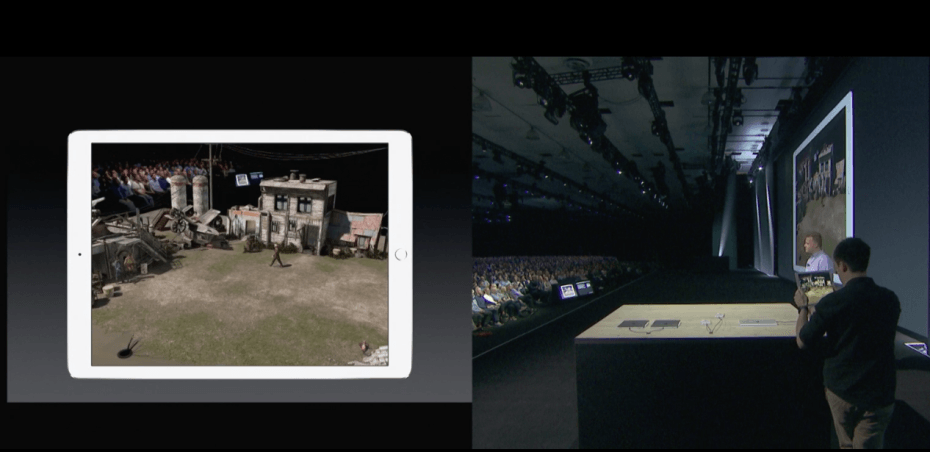Epic Games’ Unreal Engine 4 (UE4) technology was the driving force behind two key demonstrations at Apple’s Worldwide Developer Conference (WWDC) in San Jose, California. Industrial Light & Magic (ILM) showcased its HTC Vive real-time cinematic demo featuring Darth Vader on the Star Wars lava planet Mustafur, which ran on Macs for the first time and featured Unreal Engine in VR mode. Additionally, Peter Jackson’s company, Wingnut AR, took the stage to give a preview of what augmented reality (AR) gaming could look like using an iPad Pro and a tabletop to bring a sci-fi war to life.
Tim Sweeney, CEO of Epic Games, told AListDaily that Apple’s move into AR with its ARKit brings the technology to hundreds of millions of iPhone and iPad users right away. In fact, Epic’s UE4 technology supports ARKit now, allowing game developers to start creating new types of games today.
“You don’t need to wait if you have access to Apple dev system; just go to UnrealEngine.com and get started,” Sweeney said. “It’s here, it’s now, it’s ready.”
This is good news for brands, as Disney’s ILMxLab showcased with Star Wars. UE4 is being used to not only make Star Wars movies and power Disney’s Star Wars theme parks, but it’s also the tech behind ILMxLab’s virtual reality experiences and augmented reality demos.
“AR could blur the distinction between what you see in a movie and what you see in the real world when it comes to everything from marketing surrounding the movie to games and other interactive experiences,” Sweeney said. “This technology will ultimately create a new type of experience that’s in some ways similar to a movie and in some ways similar to a game, but not analogous to anything.”
Sweeney noted that 20 years ago, digital convergence completely failed in trying to put movie games on CD-ROM, but augmented reality ushers in a new mass market platform to capitalize on across film, television and brand characters.
“Now we have all the technology for convergence to succeed and a vision to create something that combines a weekly TV show with the integration of real life, which combines fictional characters and allows social interaction all linked together in some sort of new global experience,” Sweeney said. “Something big is coming and people will recognize it as different from movies just as movies and games are different from pinball or radio.”
Nick Whiting, technical director of VR and AR at Epic Games, said Niantic helped pave the way for Apple’s move into AR with Pokémon GO last year.
“Pokemon GO brought the whole idea into the mainstream, so you don’t have to convince people to buy a device,” Whiting said. “The barrier to entry is zero. A social experience can only work when a critical mass of people you know in real life have a frictionless entry point, and that’s the case with iPhone and not the case with any other platform in the world.”
ILMxLab previously released a UE4-developed Magic Leap demo that brought R2-D2 and C-3PO into the living room. “When you see R2-D2 or C-3PO in AR, you can bring those characters into your world,” Whiting said. “It feels magical. It allows companies to connect these characters with people in a more personal way.”
The process of developing games and other experiences will be straightforward, according to Sweeney. “Engines exist in the industry because we solve the hard tech problems and allow the developers to focus on creating the game and be able to build things more productively,” Sweeney said.
Sweeney also said that developers can creatively use the entire world as a starting level to build on top of. “You can build AR game objects without having to worry about backgrounds or locomotion because people can walk around with their legs and the device will track it, verses VR where you have to build everything out and deal with the challenge of locomotion,” he explained.
Whiting noted that social interaction with real people is much easier in AR, since developers can build a shared reality game outdoors in a real environment. “You’re interacting with the world through the social connections of the device and real world people, creating a shared virtual experience,” Whiting said. “The accessibility of AR is extremely broad. My mom might use a map app in AR. It’s what the smartphone was to cell phones. AR is an exciting new platform.”
Brands have been early to explore VR, even though the initial audience has been small. Apple’s entry into VR will give Mac owners access to this content. Sweeney believes the VR audience could be doubled or tripled thanks to Apple’s entry. On the AR side, since there are hundreds of millions of iPhones and iPads globally today, early brands that dive into AR will have a very large audience to target with experiences that are sure to be shared.
While gaming will be a key early focus for AR, Sweeney sees this technology evolving across all industries and opening up new opportunities for everyone from content creators to brands.

